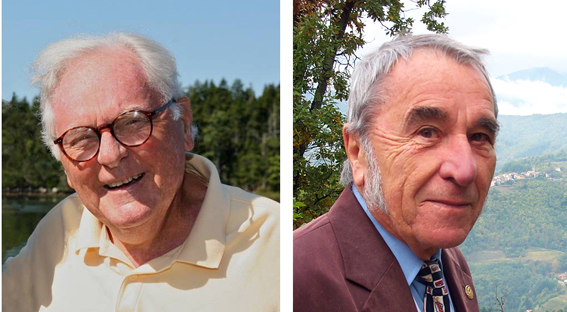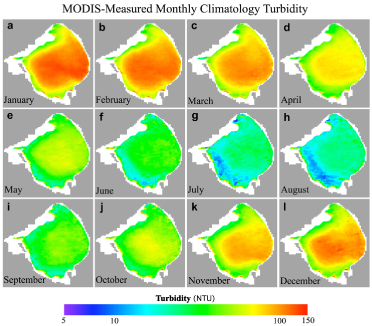

|
|
Registration is now open for the first International Ocean Colour Science meeting (Darmstadt, Germany 6-8 May 2013) - please see the official website for the meeting at iocs.ioccg.org. The primary focus of the IOCS meeting is to build and strengthen the international ocean colour community by providing a structure and mechanisms to collectively address common issues and goals. The aim is to achieve the best quality ocean colour data that meet scientific, environmental, climate and operational needs through international collaboration and scientific and technological innovation. In addition to providing a forum to develop a strong voice for the community, the meeting will also offer an opportunity to interact and collaborate with other ocean colour scientists. Registration is free, but all participants must be registered in order to attend the meeting. The program has not yet been finalized but will include talks by space agency representatives on the status of existing missions, how and where to get the data, and information on future missions. In addition there will be splinter sessions, panel discussions and talks by invited keynote speakers as well as comprehensive poster sessions to review the progress of scientific ocean colour research. The meeting will close with a session on future directions and needs. We will be accepting proposals for splinter sessions in a number of topical areas. To submit a proposal for a splinter session please go to: iocs.ioccg.org/program/splinter-sessions/.
IOCCG Report 13 on Mission Requirements for Future Ocean-Colour Sensors has just been sent to press. This report is the result of a working group chaired by Charles McClain, Gerhard Meister and Paula Bontempi (NASA GSFC, USA) that addresses the requirements for more complex and sophisticated ocean-colour sensors. The report requirements recognize not only the evolution of oceanographic and Earth system science questions and multi-decadal scientific discoveries since the CZCS era, but also the value of a continuous time series of global, climate quality, ocean-colour data to support a virtual constellation of ocean-colour sensors and enable large-scale oceanographic research. This report is a follow-on report to the first IOCCG report edited by Prof. André Morel (IOCCG Report 1, 1998) that used the lessons learned from the CZCS data to quantify the minimum requirements for retrieving phytoplankton chlorophyll-a from space for subsequent ocean-colour sensors. This report is dedicated to the memory of Prof. Morel who sadly passed away in September 2012 The views presented in Report 13 outline the trade-offs between scientific objectives and instrument requirements to achieve these objectives. The report will be printed and mailed within the next few months, but an electronic version of the report can be downloaded from the IOCCG website at: www.ioccg.org/reports/. Note that hardcopies of Reports 11 and 12 will also be mailed within the next few months.
 September was a very sad month for the ocean colour community when we learned of the passing of two pioneers in the field of ocean colour remote sensing and ocean optics: Charlie Yentsch (left), founder of Bigelow Laboratory for Ocean Sciences, and André Morel (right), one of the founding members of the IOCCG. Over their lifetimes they have both helped to establish the foundations for the science of ocean colour from space, and inspired many in their long and productive careers, both as mentors and as friends. They were both true gentlemen and will be sorely missed by the entire ocean colour community. On behalf of the IOCCG Committee we extend our deepest condolences to their families, friends and colleagues.
 In terms of data assimilation, algorithms are developed for the fusion of satellite OC data and in situ measurements from platforms (buoys, drifters, gliders etc.). The assimilation models are of three types; IOP assimilation, Chl-a concentration assimilation, and geostatistics. To support these developments, fields campaigns will be carried out in the Ligurian sea and North Atlantic in 2013/2014. A 15-year time-series of new products (and associated error characterisation) will be generated, namely: Chlorophyll, Net Primary Production, Particle Size Distribution, Particulate Organic Carbon, Phytoplankton Functional Types, plus others (for on-demand service). Uptake and usage of these new capabilities will be promoted among a large range of users in the scientific, institutional and private sectors. For more information please see the OSS2015 website or contact: info@oss2015.eu The research leading to these results has received funding from the European Community's Seventh Framework Programme ([FP7/2007-2013]) under grant agreement n° 282723.
Several new positions have been added to the Employment Opportunities section of the IOCCG website including two Ph.D. Graduate Research Assistantships and a Research Associate at Michigan Technological University (USA), a PhD and post-doc vacancy in marine optics at the University of Oldenburg, Germany and several post-doctoral fellowships in USA, Western Australia and Japan. For further details on these positions see: www.ioccg.org/employment.html.
|
Lessons learnt from MERIS were highlighted and recommendations for the future OLCI were formulated, and included (amongst others) the importance of building a permanent science team to work on algorithm testing/improvements as well as establishing a sound plan for pre-launch, post-launch and across mission cal/val activities to ensure continuity and traceability. In addition, the importance of bridging the gap between MERIS and OLCI was highlighted and strategies for bridging and filling the data gap were discussed. The need for the availability of, and access to, ground-based reference data for calibrating and validating space data was repeatedly stressed. A recommendation was also made for the OLCI dataset to be made available in full resolution for the open ocean (as well as coastal waters) to detect features such as small scale eddies and associated plankton booms. It was concluded that easy and open access to Sentinel-3 data via on-line interfaces is key to ensuring a rapid take-up by services, science and new users. The Final Report of the Sentinel-3 workshop can be downloaded at:
A call to establish a Sentinel-3 Validation Team (S3VT) can be found at earth.esa.int./aos/S3VT. In the framework of a GMES collaborative agreement ESA and EUMETSAT are opening a call "To engage world-class validation expertise and activities to complement Sentinel-3 routine validation activities and ensure the best possible outcomes for the Sentinel-3 Mission". The call is open to relevant and interested groups and individuals worldwide. The deadline for the submission of Sentinel-3 Validation Team proposals is 31 December 2012.
NASA has completed negotiations and finalized the contracts for the spacecraft and instruments that comprise the Joint Polar Satellite System-1 (JPSS-1), NOAA's second next generation operational polar-orbiting satellite, planned for launch in 2017. JPSS-1 will follow the Suomi National Polar-orbiting Partnership (Suomi NPP) satellite to maintain continuity of weather and environmental observations. A number of instruments on JPSS will be used for weather forecasting, and environmental and climate monitoring, including the Visible Infrared Imager Radiometer Suite (VIIRS). The JPSS-1 VIIRS instrument will gather data on a wide range of Earth's properties, including the atmosphere, clouds, radiation budget, clear-air land and water surfaces, and sea surface temperature. The JPSS program is the restructured civilian portion of the National Polar-orbiting Operational Environmental Satellite System (NPOESS) program and this step represents the final action to transition the instrument contracts to NASA. NOAA is responsible for the JPSS program with NASA's Goddard Space Flight Center procuring and integrating the system elements.
Several new publications have been added to the IOCCG Recent References list, including a paper by Sapiano et al. (2012) on Establishing a global climatology of marine phytoplankton phenological characteristics published in J. Geophys. Res. Ten-year, global maps of the mean date of bloom onset, peak concentration and termination, and bloom duration were constructed by extracting these phenological metrics from Generalized Linear Models (GLM) fit to time series of 1o x 1o daily estimates of SeaWiFS chlorophyll concentrations dating from Sept. 1997 to Dec. 2007. The fitted models quantitatively define the annual cycle of phytoplankton throughout the global ocean and from which a baseline of phenological characteristics was extracted. The analysis revealed regionally consistent patterns in the shape and timing of the annual cycle of chlorophyll concentration that are broadly consistent with other published studies. Mean bloom (a) onset, (b) peak and (c) termination extracted from the fitted models for SeaWiFS (click on image to enlarge). The results showed that a single bloom predominates over the global ocean with secondary, autumn blooms being limited in both location and spatial extent. Bloom duration tended to be zonally consistent, but meridionally complex and did not become progressively shorter with increasing latitude as is sometimes depicted. Both the shape of the annual cycle and the phenological climatologies can be used in future studies to detect significant departures over time. In another paper by Wang et al. (2012) the authors use data from MODIS-Aqua to characterize water turbidity in several of Florida’s lakes. Based on a strong correlation between water turbidity and normalized water leaving radiance at 869 nm, a new satellite water turbidity algorithm was developed which has important applications for water quality monitoring and measurements for turbid inland lakes. Wind waves and hurricanes were found to have the largest influence on turbidity trends in Lake Okeechobee, while tides, currents, wind waves, and hurricanes influence the Caloosahatchee and St. Lucie estuarine areas.  Monthly climatology (2002 to 2010) of MODIS-Aqua turbidity images for Lake Okeechobee (click on image to enlarge). Other related new publications include a paper by Aurin and Dierssen (2012) on ocean colour remote sensing in CDOM-dominated, mineral-rich coastal and estuarine waters (Remote Sens. Environ. 125), a paper by Bricaud et al. (2012) on spatial-temporal variations in phytoplankton size and colored detrital matter absorption at global and regional scales (Global Biogeochemical Cycles, 26), and a paper by Polovina and Woodworth (2012) on "Declines in phytoplankton cell size in the subtropical oceans estimated from satellite remotely-sensed temperature and chlorophyll, 1998–2007" (Deep-Sea Research,77-80).
|
|
Material for possible inclusion in the IOCCG Newsletter should be submitted to the Project Scientist, Dr. Venetia Stuart
Subscription to the IOCCG Mailing List. Participants receive a brief summary of the IOCCG Newsletter by e-mail (quarterly), as well as hard copies of IOCCG Reports as, and when, they become available.
|
|
|
|